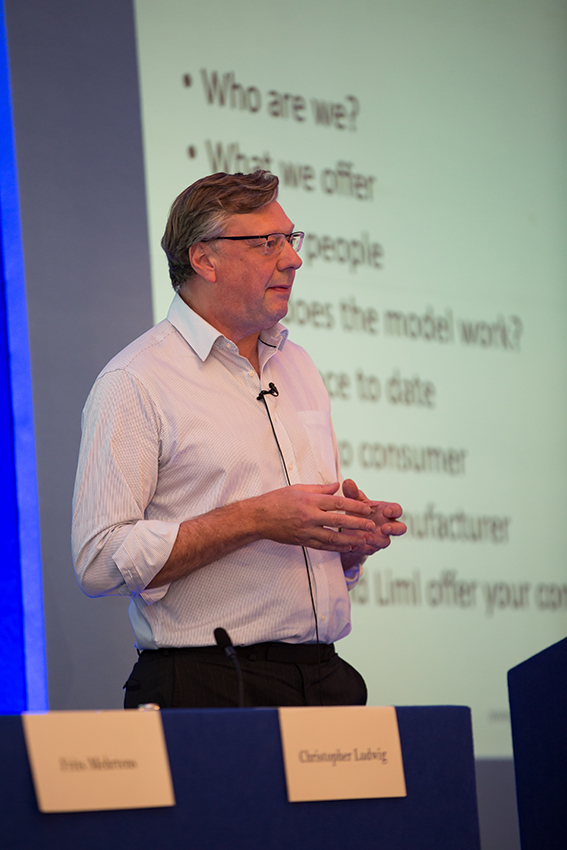 Experts at this year’s ECG Conference in Hamburg pointed to the risks and rewards for outbound logistics of the automotive industry’s shift towards digital technology and e-commerce[sta_anchor id="1"]
Experts at this year’s ECG Conference in Hamburg pointed to the risks and rewards for outbound logistics of the automotive industry’s shift towards digital technology and e-commerce[sta_anchor id="1"]
Despite its recent run of economic recovery and relatively strong growth, the European finished vehicle logistics industry could become a victim of technological change – whether in the form of a digital app or from changing customers expectations – if it doesn’t adapt to new demand and find ways to innovate.
At the same time, shifts to digital technology in the wider automotive industry, from connected cars to online vehicle shopping and trading, could offer logistics providers new business opportunities and ways to add value to the vehicle purchase and delivery experience.
These were some of the messages from speakers at the 2016 ECG Conference, held October 21st in Hamburg, Germany, as vehicle logistics experts debated the impacts that digitalisation could have on the sector.
Wolfgang Göbel (pictured left), who took over as president of the Association of European Vehicle Logistics (ECG) in spring, pointed to a sector that has generally been slow to innovate and invest in new ideas and technology. While part of the reason has been a prolonged slowdown in the European vehicle market that has only recently begun to reverse, along with the sector’s low margins and high asset costs, he also pointed to a particular “lack of fantasy” and of risk-taking in vehicle logistics.
In this story…
Göbel, who is also the head of sales and marketing for Horst Mosolf, a major German-based vehicle logistics firm, admitted that the vehicle logistics sector had little-to-no equivalent venture capitalist culture that allows for the types of risk seen in Silicon Valley and the wider technology sector. Nevertheless, there is a growing interest in logistics and transport among tech investors, following the success of Uber and the potential of autonomous driving technology, and a number of start-ups are emerging with the aim of digitising the general logistics chain, including freight booking, customs clearance, insurance and much more.
This focus is occurring even though the traditional vehicle logistics sector in Europe – for various reasons, including legal hurdles – has at times struggled to automate and digitise processes even where it should be relatively straightforward, such as paperless billing and documentation.
The e-CMR protocol, for example, a UN convention that allows logistics companies to eliminate paper delivery documents for international transport, has so far only been ratified by ten countries in Europe, including most recently by France. However, the industry will be held back as long as major automotive markets such as Germany hold back from ratifying the protocol.
Gaps also remain in visibility and tracking orders and vehicles throughout the supply chain.

Chris Godfrey, general manager for outbound engineering at Renault Nissan’s Alliance Logistics Europe, challenged both vehicle logistics providers and carmakers with being too slow to change and too entrenched in current processes to realise the potential for improved services. He suggested that the industry had yet to fully exploit opportunities to increase real-time traceability of products through technologies such as telematics, or to offer customers the chance to expedite their vehicle delivery through paid services, similar to those offered by Amazon.
For example, despite many logistics providers having telematics in their trucks’ on-board systems, Renault Nissan’s outbound logistics providers have not approached the carmaker with options to use these systems for tracking deliveries. “Not one supplier has done this and we have more than 40 [trucking] suppliers across Europe,” he said.
Meanwhile, carmakers, including Renault Nissan, BMW and Jaguar Land Rover, are now looking more closely at using their cars’ in-vehicle systems to improve distribution.
Godrey also suggested that carmakers and logistics providers were not looking at the potential for value-added services offered by shifts towards e-commerce. The time when customers customise and buy new cars completely online and choose their own delivery locations, including to their own homes, “is not a hundred years away”, he said. The industry should prepare to service this changing demand.
“It raises questions, such as can we do expedited deliveries? If the customer wants it, can we get him to pay for it?” asked Godfrey. “That would give me added value as a business.”
If stakeholders at OEMs and logistics providers didn’t start to explore this potential more deeply, then other companies would surely beat them to it, he warned. “This industry is like a dinosaur – it has to change. We are moving too slowly, and if we continue to do so we will be overtaken by Amazon or someone like it,” said Godfrey.
The perfect victim? [sta_anchor id="2"]
Wolfgang Göbel and other experts agreed that vehicle logistics faced a number of risks to its business model in Europe. Current processes could be widely surpassed by end-customer expectations, as outlined by Godfrey, as well as by shifts to car sharing or other changes in vehicle use and ownership.
Ben Waller, associate director of vehicle distribution research and consultancy firm ICDP, pointed to research that suggested carmakers’ performance in total order-to-delivery lead times and accuracy had actually been worsening even as technology improved. For example, average factory to dealer times have increased by 18% between 1994 and 2012, according to ICDP surveys.
Meanwhile, order traceability and estimated arrival times at dealers and customers remain spotty; some manufacturers don’t offer them at all at the time of order, while ICDP estimates that 13% of orders are delivered late compared to original promised dates to dealers.
While the data is several years old – ICDP is currently updating the survey – the recent growth in European vehicle sales, combined with transport capacity shortages in many parts of the continent, such results are likely to ring true for today's market as well.
Waller suggested there were a number of reasons for this performance, not least of which included a significant fall in investment in logistics capacity among providers during the prolonged decline in vehicle sales in Europe between 2007 and 2014. But he also said lead times had lengthened as a result of poor long-term planning and a lack of sharing information on future models and production between OEMs and logistics providers; he also pointed to a high variance in production output in plants and a lack of order data sharing between stakeholders. For example, only half of OEMs polled by ICDP said logistics providers had access to up-to-date information on a vehicle’s status in the production schedule.
A number of OEMs, including General Motors’ Opel/Vauxhall division, have more recently made efforts to improve this production stability and order transparency in the supply chain.
 ICDP's Ben Waller suggested that poor planning between OEMs and providers has contributed to lengthening lead times
ICDP's Ben Waller suggested that poor planning between OEMs and providers has contributed to lengthening lead timesAlong with changing customer expectations, vehicle logistics may also come under threat from technology firms, such as ‘Uber’-style apps or new entrants. While there may be limited signs today of an app that could upend vehicle logistics’ asset-heavy business model, that doesn't mean it couldn’t happen. “Vehicle logistics could be the perfect victim of an algorithm,” Göbel told journalists during a press conference during the event.
“There is room for a third party to come in and rewrite the rules,” added Ben Waller. “Something like an Uber, which takes an existing system and raises the game. Uber has built more trust between users and drivers by automating everything from hailing, invoices and insurance. Something similar could happen in vehicle logistics.”
Online opportunities[sta_anchor id="3"]
While digitalisation may threaten aspects of Europe’s vehicle logistics sector, however, it also offers it opportunities for growth and efficiency. As Godfrey indicated, a growth in online car customisation, purchasing and delivery could open the way for new, premium logistics services.
 Hakan Koç's online used car platform, Auto1 Group, now sells more than 300,000 cars per year
Hakan Koç's online used car platform, Auto1 Group, now sells more than 300,000 cars per yearThe online auction and sales of used and remarketed vehicles is already one such area. An example is the Auto1 Group, an online marketplace for used cars that has grown to selling more than 300,000 cars per year since its inception in 2012, working across 22 European countries and 25,000 dealers. According to Hakan Koç, co-founder and joint chief executive, the company has growing demand for coordinated and effective logistics services, including across its 30-plus vehicle compounds and complex flow of international vehicle exchanges.
Koç said he wanted to work together with logistics providers and carmakers to reduce empty loads on return lanes, in particular through the use of shared data and tracking platforms. “We are looking to intensify partnerships by opening up our interface to include real-time information flows,” he said.
John Merry, a former chief executive of a number of UK and mainland European vehicle logistics firms, has recently founded London Interactive Marketing (LIML), an online platform that helps carmakers to serve customers in areas that might not be located close to dealer networks. The platform allows potential customers to arrange test drives of new car models from their home or chosen location based on their own schedules. It carries out bids and sales between customers and dealers, purchase and exchange of existing cars, financing, and delivery of cars direct to a customer’s home. It also arranges vehicle pickup for aftersales servicing for three years following purchase. Aiming for a international customer base within London, the service is offered across 16 languages.
LIML has been working with Mazda in London, where it has helped the carmaker expand its market share in a number of key markets, according to Merry. While the service is currently working in conjunction with dealers, it does have the potential to bypass dealers altogether, he said. The company is now in talks about expansion into other markets, including in continental Europe.
 John Merry's new LIML venture demonstrates how digital platforms could expand vehicle sales and delivery service
John Merry's new LIML venture demonstrates how digital platforms could expand vehicle sales and delivery serviceSuch online platforms, together with carmakers’ own efforts, suggest that vehicle logistics providers could benefit from a digitised automotive marketplace. There is also scope for considerable operational efficiency, for example as manufacturers and logistics providers look to new technologies and methods to improve vehicle tracking.
Chris Godfrey pointed to ECG’s ‘Digitalisation Working Group’, in which carmakers including Renault Nissan, JLR, Opel and PSA Group are working with a number of vehicle logistics providers to agree a set of standard communication data for using telematics in vehicle distribution.
Göbel pointed out that vehicle logistics providers would have a key role to play as carmakers used their telematics systems for vehicle tracking, since the data that the vehicles communicated to carmakers would not always be the same as shared across the supply chain. “We will still need to set up and run a system, which will be interesting and important to work out,” he said.
Ben Waller pointed to further opportunities to increase asset utilisation, reduce empty miles and improve overall order-to-delivery times by moving towards a virtual network, where the sector’s various vehicle delivery flows were more transparent and effectively shared across carriers, based on real-time demand. Such ideas have been discussed since the turn of the 21st century but continue to be held back by a lack of trust as well as worries over service level quality, he said.
The online winner takes it all [sta_anchor id="4"]
Whether carmakers and logistics providers can overcome this long-held resistance remains to be seen. However, the risk of falling behind in technology remains real.
Göbel pointed out that fairly large vehicle logistics companies such as Mosolf could “close the gap” in logistics service by improving their IT systems in areas like transport and yard management. “We need to do this and to increase the number of innovations in the sector,” he said.
However, Waller pointed out that the large-scale IT players that tend to dominate manufacturing and logistics today are also in danger of being surpassed by cheaper, cloud-based competitors. “Nobody wants big [corporate business management] IT products that run years over budget and never work how you hoped,” he said. “The answer for many will more likely be in low-cost apps.”
However, the line between the services such apps may offer and those of the companies they may serve could become blurred. In a press conference, Göbel and other ECG leaders drew a distinction between investing in systems for operational improvement and the sudden disruption of an Uber-type technology that could exploit the sector’s inherent inefficiencies.
Mats Eriksson, vice-president of the ECG and chief executive of Sweden’s Skandiatransport, pointed out that such disruptors tend to overwhelm existing competitors.
“As we’ve seen with Uber, Google and Amazon, it is often a ‘winner-takes-it-all’ game in the digital marketplace,” he said. “The same could happen in vehicle logistics.”
For more on digitilisation and the e-CMR protocol in Europe, read here.

























![Global[1]](https://d3n5uof8vony13.cloudfront.net/Pictures/web/a/d/s/global1_726550.svgz)









